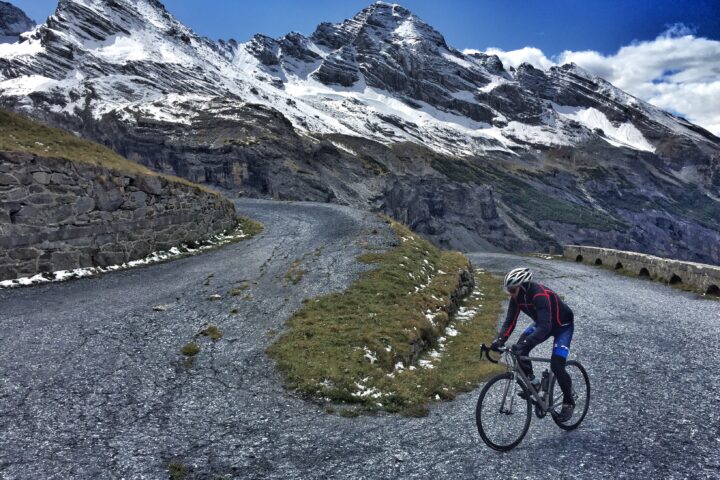Head Coach Ryan Kohler details the profound physiological impacts that altitude can have on our heart rate and power output.
Video Transcript
How Altitude Impacts Athletic Performance
Ryan Kohler 00:00
Altitude has a profound impact on our athletic performances. It impacts our heart rate, it affects our power output, and just as importantly, it has a significant impact on our mindset. What’s interesting is just how individual responses to altitude can be. That said, there are some general rules of thumb that we can use to get a better understanding of how altitude will impact our numbers and our performance. Today, we’ll dive into how power and heart rate respond to altitude.
Chris Case 00:34
Welcome to Fast Talk Laboratories, your source for the science of endurance performance.
Ryan Kohler 00:44
Alright, so let’s jump in here and look at a power file that we have, and we use this for a few of the examples that we talk about, and we look at power and heart rate response during altitude. So, what we’re going to show here first is just this TrainingPeaks, this is from our TrainingPeaks workout, and you can see a lot of different colors going on. So, we’re going to focus today on the purple, which is going to be our power, and you can see that along the axis here, and heart rate is up here in red. Some of the other metrics that you’ll see included, our green is going to be your speed, yellow will be your cadence, and then this blue line that trends throughout here is our temperature, the most important thing that we’ll look at, of course, is these two big accents, this is our elevation. So, we have these guys here as our altitude, and we’ve got as low as about 8200 feet up to about 9200 feet. So, this is going to be what we’ll use for our example, and we’re going to compare this altitude power file to more usual altitude here around Boulder.
Power Response to Altitude
Ryan Kohler 01:43
So, let’s talk about first just the general power response at altitude. This is from a study that occurred in 2015, a nice study that looked at some stage racing and power declines. So, what’s cool about this is they’ve taken mean maximal powers from one second all the way up to 10-minutes, and they’ve plotted them along here with this racing was done at sea level, then we have one to 2000-meters, two to 3000 meters and above 3000-meters. So, what we’ll see here is this is their baseline at sea level, 0% decay, and immediately when they ascend to 1000-2000-meters fairly lowish altitude, then you can see these longer time periods, this 240 second and 600 seconds, so that’s our endurance, you can see those start to decline pretty quickly, some of our peak powers are well maintained. But as we continue to ascend to higher elevations and above 3000, you can see where it’s really this additive effect, the higher we go, the more we see these declines start to occur. So, we can expect that our power and our heart rate, that response is going to just typically decline as we go higher and higher. So, when we’re preparing for an event or doing a race up at altitude, it’s important to know this so that you can help to start planning. So, what we’re seeing here is this decay in percentage, and the average that they found for the overall decay was about 12% when athletes went from sea level to 2000-3000-meters, and then about 12%, again, when they went 3000-meters and above. So, hopefully, that gives you some sense of what to expect. So, if you’re going from sea level to 2000-or-3000-meters, you can start to get a sense for okay, what’s the deficit that I should expect, if my FTP or my threshold power, does that stay 300-watts? Well, let me take maybe 12% off that. I’ll even say back when I first started coaching, this still aligns with what I’ve heard as an early coach, it was somewhere in the range of 6-12% that I was told, and over the years looking at the research that seems to fall within the expected range of those power declines.
Ryan Kohler 03:49
So, let’s move on here, and we’ll look at a specific climb. This is a cool climb here in Colorado, It’s Mount Evans, it’s a huge, huge mountain, and there’s a bike race that goes up it, we’re going to start down here, you’ll see this base elevation, 7300 feet, or about 2000-meters, and then it finishes up here at 14,000 feet, or just a little bit over 4000-meters. So, this is going to run the whole gamut of what we just saw in terms of that 2000–3000-meter range and over 3000-meter range. So, this is from an athlete that I’ve coached, and we’ve taken out all the extraneous data there, we have just purple here for power and heart rate up here in red. So, you can see again, the elevation change here in gray is taking us all the way to the top. The big takeaway here to look at is just when we break apart different segments of this race, we see that here, this athlete is maintaining pretty decent power, it’s relatively stable, but then as he ascends to higher and higher elevations, we start to see this power really decline, we see the same thing with heart rate. Then finally at the top, we see it kind of level out and this is about all he can do for that point. So, really, this is a great example of just what happens with that acute exposure to altitude. So, with this athlete having a threshold of somewhere in the mid to hundreds, we would expect him to be able to hold a fairly high percentage of that at the beginning, but then we need to account for that decline as we go up.
Power as a Percentage of Maximum
Ryan Kohler 05:13
So, what does that look like as the race sort of plays out? This is the same hill climb, Mount Evans, and I’ve just pulled out different segments. So, this is about 2700-meters, here were over 3000, and at the top are over 4000-meters. So, at the base is holding about 218, and as I said, his threshold power was in the mid-two hundred. So, he was holding a fairly high percentage of that, which is completely reasonable, then as we move up, get midway up the mountain, we can see that sustainable power now goes down to 189, so much lower percentage of that threshold power, and then by the top even more, so 171. So, I pulled out a little power decline for this athlete here, and that’s over here on the secondary why, and we see a 13% decline just from 2700-meters to 3400, and then from 3400 to over 4000, we get an additional 10% decline, so pretty significant. So, as a coach, I look at this, and really want to say, okay, let’s talk about this for this particular athlete, this is what we see. So, now when he goes and does additional races, or is doing training or does like an altitude camp, we can now make some expectations for what we need to do to account for his training ranges. So, we don’t want to leave the training ranges the same. If this is an athlete that lives at sea level and is competing at altitude, we don’t want to take those sea-level training ranges and say, oh, go train in Boulder and use your same ranges that just won’t work, he’s going to be fatigued, he’ll be working too hard. So, this one we can take and start to apply for our athletes, all right, well, let’s say yeah, 10 to 13%, if you’re traveling up to higher elevation to do some training, let’s adjust those ranges down and give you more appropriate ranges so that you can actually get some good quality training in and not leave to fried.
Ryan Kohler 06:51
So, then if we look at that from absolute levels in terms of looking at now percentage of FTP, these are two different segments that I’ve pulled out both from different races. This one I wanted to look at in terms of power as a percent of FTP, and just zero in on two different segments. So, what we have here is a lower elevation segment, this is around Boulder at 5500 feet, a little bit below 2000-meters. Then we have another event here at almost 10,000 feet or right around 3000-meters. So, again, we get that nice spread, where we start to see those bigger declines happen. So, what we’ll see here is total power of 274-watts at this usual altitude of Boulder, but then when we go up higher and start to approach 10,000 feet, we see the sustainable power at 231. So, quite a big difference. These, again, were two 10-minute segments that were meant to be part of a race. So, if we look at that decline, we see here’s the 274 and a 231, a pretty large difference in our absolute powers. Then if we look at this in terms of a percentage of threshold, well, at Boulder, we’re holding about 94% completely reasonable for a longer race effort, because we’re not going to be racing right at threshold or above the whole time because this is a long event, but when we go up to these higher elevations, now we’re only holding about 80%. So, this again, can help inform future racing, so with this athlete, we see, okay, you finish this race, you had a pretty good day, you held about 80%, so if you’re doing training up at altitude, or you have some more races coming up at altitude, we can start to make some assumptions and help with pacing to say, all right, well, let’s not exceed that too early, maybe 80% is that cap, that’s a pretty safe place for you to be.
Heart Rate Responses to Altitude
Ryan Kohler 08:26
Alright, so then we’ll shift gears, we’ve talked a little bit about power, now let’s shift gears over to heart rate, we’re going to do the same thing, and we’ll look at again, this will be Boulder, our usual elevation here about 5500 feet. This again is going to put us at about 8500 feet up in the mountains and about 2600-meters. So, we know absolute power declines, we’ve seen that from the research, but what about heart rate? So, there’s one thing that I mention is there’s a lot of variability in the studies, we see these averages, 12% roughly, right? We can assume about a 12% decline as we get to 2000-3000-meters, that’s a great guideline to help you start and make some expectations on what your power can be. What about heart rate? There’s some good data on heart rate too, but we always want to take these and say, well, they’re a lot of them are done on elite athletes, a lot is done on untrained athletes, we have to consider the climatization level of the athlete in the studies, so there’s a lot of potential variabilities that can come into play. That’s why this is good to remember that these are general guidelines, but use your data, do some analysis like this, and then start to figure out just how much you see a decline so that you can better pace and adjust your training ranges for altitude. Looking at this one, we’ve got our lower elevation 339-watt effort, we’ve got our higher elevation 337-watt effort, basically, the same power being put out, but if we look at the peak heart rate response for these 10-minute segments, we can see 169 beats for this usual elevation. When we go up here to 2600-meters, well, now we’ve dropped quite a bit about 10 beats in heart rate, so that really helps to inform our same thing, training ranges for heart rate. If we’re going and doing a race like this, but then we’re also expecting to go and do some training, or we’re going to have a training camp or a vacation at higher altitudes, well, we need to go and say, I might be able to do the power, but let me change my heart rate ranges to help inform that. What I’ll say is this effort, while we don’t have it plotted anywhere, this effort, the perceived effort of this is significantly higher. Remember when you go to altitude, we have that reduced oxygen, that’s where you’ll see in the research, hypoxia is the typical word that’s thrown around to suggest low oxygen availability. So, when we get here, at these higher elevations, one of the first responses is an increased ventilatory response. So, we’re just breathing more in order to help the body deal with reduced oxygen. So, that’s one of the things that happens is we’re just going to see a little bit of a lower heart rate as well.
Heart Rate as a Percentage of Maximum
Ryan Kohler 10:45
So, as we did before with power, let’s look at heart rate as a percentage of maximum. So, this is again, a 10-minute race effort, and pulled out a few things here. This is not TrainingPeaks, this is from intervals that I used to use, so a little bit different way to look at it, but I wanted to specifically look at the percentage of max heart rate over here. So, two efforts, this is over in Boulder, this is up at higher elevation, and our percentage of max heart rate here you can see this heart rate line kind of trending up nice and flat, this would be very indicative of someone who’s, you know, kind of on the rivet threshold effort going really solid and steady, we don’t see much change there. I’ve marked this specific area here, just because it allows us to highlight at that point, the steady effort, this athlete was doing about 95% of his maximum heart rate. So, pretty close to a max effort, which is great. We would expect that for an athlete at sea level or an athlete that is acclimatized to say Boulder in this area. Down the bottom, we have a higher elevation, so that if we look down here, we can see relatively stable heart rate again, there are some terrain changes that are making it go up and down a little bit, but if we look at the marker in here, we see that we’re about 90%. So, now we have lower elevation or usual elevation, and up at 2600-meters, we’ve got 90%. So, again, this helps to inform our pacing. So, if we see that we’re up at a race, and we’re not able to hit that high percentage of our max heart rate, that’s fine, we just have to know why.
Rule of Thumb When Racing at Altitude
Ryan Kohler 12:12
So, there’s a great study in 2018, that looked at max heart rate responses at higher altitudes, where they found, and again, this is a great rough guideline is for every 1000-meters that you gain, there’s about a two-beat per minute decline in max heart rate. So, again, if you’re traveling to a higher elevation, or you have a race at a higher elevation, and you’re coming from sea level, you can use that as a general guideline to say, all right, if the max is 180, and I’m going to 9000 feet, now I can just take two beats per 1000-meters and get a sense for how much my max heart rate will decline. Then we have to consider, well, what’s the change that we can expect in terms of percentage of max heart rate, and that can help adjust our pacing for the event or if we’re going to train help us then inform how we should adjust our heart rate ranges for the optimal training.
Ryan Kohler 12:58
As you’ve learned, altitude has a significant impact on our athletic performance. Hopefully, today, we’ve given you some tips to deal with how heart rate and power will decline and just as importantly, how you can mentally prepare for this challenge. We’ll see you next time here at Fast Talk Labs.



